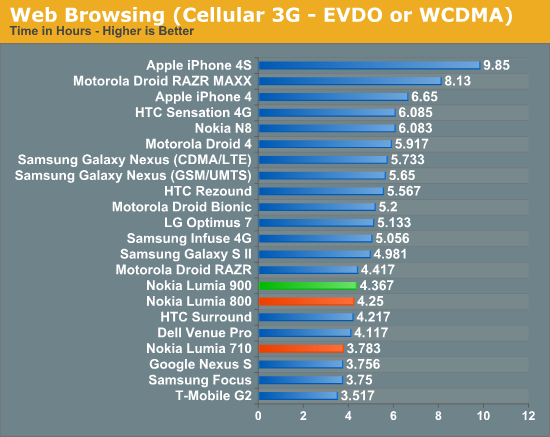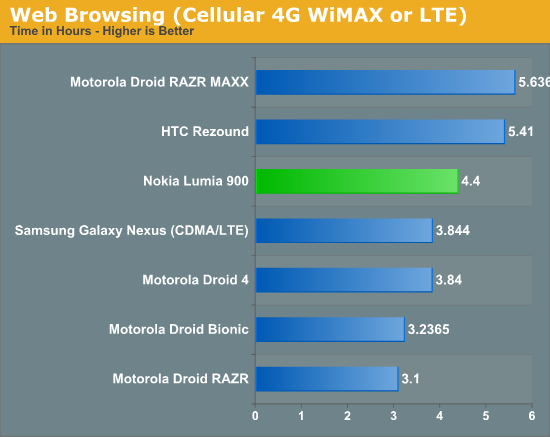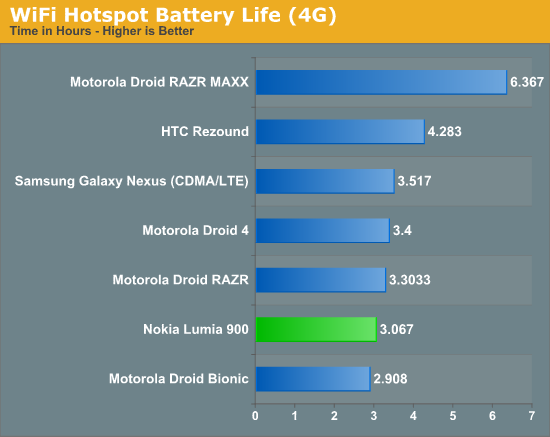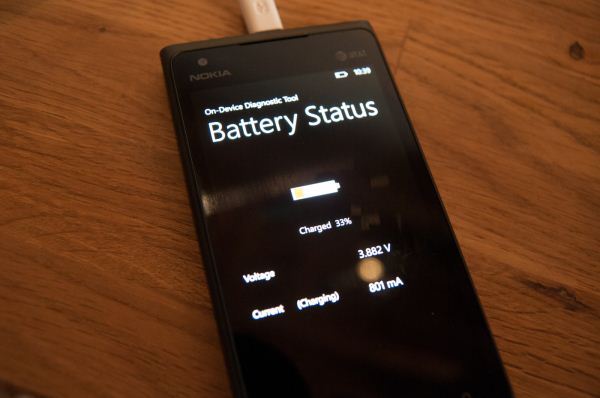Nokia Lumia 900 Review - Windows Phone with LTE
by Brian Klug on April 3, 2012 9:00 PM ESTBattery Life and Charging
First things first, the Lumia 900 has none of the charging issues or problem behavior that initially plagued the Lumia 800. In the course of our battery life testing, I’ve repeatedly discharged and charged the phone completely and the Lumia 900 charges up from completely empty like a champ. It seems those initial growing pains are now squarely behind Nokia.
In addition, Nokia has gone with a compact 5W charger (5V 1A) that the Lumia 900 takes full advantage of during a charge cycle - I repeatedly saw the Lumia 900 draw over 800 mA during the charge cycle in its diagnostics menu, which is awesome. One of the things I’ve seen requested a lot is also measurement of just how long devices take to charge from completely empty - I measured the Lumia at almost exactly 3 hours with repeatability, using the supplied charger. The Lumia 900 uses an internal 1830 mAh, 6.77 Whr battery which is about what you’d expect for a device which includes a 4.3" SAMOLED display and LTE.
So how does battery life fare on the Lumia 900? To find out, I turned to our regular suite of battery life tests which consist of pages loaded endlessly until the phone dies, with the display set as close to 200 nits as possible. In the case of the Lumia 900, this actually ends up being the max brightness setting (WP7 offers three settings and auto). Due to time constraints, I haven’t run the WiFi page loading test, but have run the cellular tests over both 3G WCDMA and 4G LTE.



When it comes to web browsing, both the 3G WCDMA and 4G LTE results end up being pretty close at around 4.4 hours. This tells me that we’re pretty much dominated by the display’s power drain in that neighborhood. The web browsing tests tend to be pretty brutal on AMOLED devices to begin with, partly because we’re dealing with black text atop a white background. In practice I feel like the Lumia 900 does subjectively a lot better than these results really would lend you to believe. If you can believe it, we actually haven't formally published any AT&T LTE device results yet, so the Lumia 900 is our first.
In addition I’ve also run our hotspot tethering test on 3G WCDMA and 4G LTE, which consists of four tabs of our normal webpage loading suite alongside a 128 kbps MP3 internet radio stream all loaded on one wireless client.


The results of the tethering test demonstrate just how taxing constant connectivity can be for the current crop of 45nm basebands, and the Lumia 900 does pay the price for having a relatively hungry one. Our testing was done in good AT&T LTE and HSPA+ coverage, and interestingly enough the results are pretty close for the two air interfaces at around 3 hours. Jumping onto LTE and running the same test incurs a half hour hit.











128 Comments
View All Comments
NeoteriX - Wednesday, April 4, 2012 - link
Google Maps:10 miles from a given point on a map.
...it's enough for all of Manhattan and nearly all of New York City.
Braumin - Wednesday, April 4, 2012 - link
My wife has the Lumia 800. It is a great phone, and the 900 just builds on that. Thank God they got rid of the magnetic door over the USB port.I'm excited to see what Nokia can bring to the table with WP8. I am a big fan of WP7.5, but I know it has some shortcomings. I can't see how those won't all be fixed with WP8 running on the Windows 8 kernel. Obviously Microsoft and Nokia don't want to talk about it (which is too bad) but for business reasons, it makes sense, but all the complaints about hardware should evaporate. Windows 8 already has support for high ppi displays, multicore, LTE, and everything else. Six months seems like a long time away.
The Lumia 900, especially at the price it is offered, should be a great phone for many people. I'll keep my old LG Optimus 7 until Apollo hits though.
j3ff86 - Wednesday, April 4, 2012 - link
174 nits of brightness is super pathetic. I bet Nokia uses a very aggressive ambient light sensor like they did on the N8 and E7. You can disable the light sensor on those phones with 3rd party software but I don't know if WP7 has similar apps.kyuu - Wednesday, April 4, 2012 - link
It's way beyond sufficient for indoor viewing... the only place you might need more brightness is outside in daylight. I guess you missed the part where Brian said that the clearblack feature was pretty effective at reducing glare/reflections and, due to that, the display was quite visible even in the outdoor daylight setting.If you can see the display clearly even in daylight, why would need or want more brightness? So you can drain the battery faster for no real benefit?
steven75 - Wednesday, April 4, 2012 - link
So it's only bad in real life situations where people use their phone? Ok, then.tipoo - Wednesday, April 4, 2012 - link
That's not what he said. The display has one of the lowest reflection indexes in a phone or tablet, its very good at reducing glare, so even if the brightness in absolute terms is lower, in real world use its pretty good since its not competing with the sun as much.ecuador - Wednesday, April 4, 2012 - link
Ehm... You have a N9 right there? Why don't you post a review? It is way too late now, but better late than never?tipoo - Wednesday, April 4, 2012 - link
It's an 800 with a dead OS. There's your review :)Beerfloat - Wednesday, April 4, 2012 - link
You mean it's an 800 but with another dead OS right :)But seriously, bring on the HTC One X review. Now there's a practically perfect smartphone.
tipoo - Wednesday, April 4, 2012 - link
Agreed, but I want the One X with Krait rather than Tegra 3, that one's not out yet.